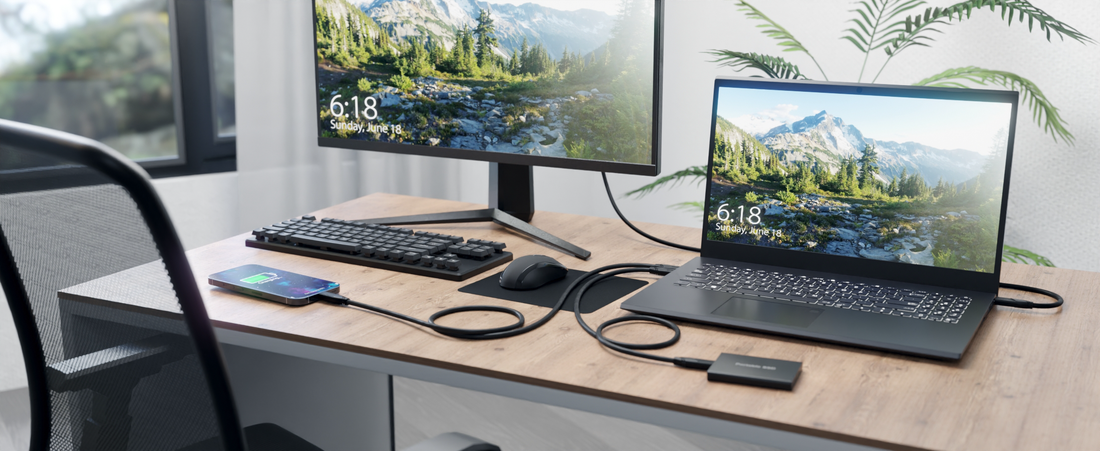
CONNECTING THE MONITOR VIA USB-C
Share

Connecting a monitor to a PC, laptop, or even a smartphone has become particularly easy and convenient nowadays via a USB-C port. Does this mean DisplayPort and HDMI are obsolete?
USB with a Type-C connector is extremely versatile: Thanks to the multifunctional properties of this standard, not only video signals but also power and data can be transmitted using a single cable. However, not all USB-C ports are the same. In this article, we explain what you need to consider, the advantages of USB-C, and the technical requirements that must be met to use the USB port of your PC or smartphone not only for charging but also for video output.
Why should you connect the monitor via USB-C?
The USB-C interface has established itself as one of the most important connections for modern devices in recent years. Besides its universal usability, there are several key advantages when using a monitor:
- One-cable solution: A single USB-C cable can simultaneously transmit video, audio, and data and – if the monitor supports USB Power Delivery (PD) – even power the connected device.
- Support for high resolutions: Many USB-C monitors support 4K resolution at 60 Hz or higher.
- Compatibility with laptops and smartphones: Modern notebooks and some smartphones allow the use of a monitor as a large display.
- Docking station functionality: Some USB-C monitors feature built-in USB hubs for peripherals.
Technical requirements for connecting a monitor via USB-C
1. DisplayPort Alternate Mode
For USB-C to transmit a video signal to a monitor, the port must support DisplayPort Alternate Mode (DP Alt Mode).
2. USB Power Delivery (PD)
If the monitor is to power the connected device, the USB-C port must support Power Delivery.
3. High-quality USB-C cables
Not every USB-C cable is designed for video transmission. Use high-quality USB-C cables that support at least USB 3.1 Gen 2 or higher.
4. Support for multiple monitors
Some modern laptops and PCs with Thunderbolt 3 or 4 allow daisy-chaining, where multiple monitors can be connected via a single USB-C connection.
USB-C vs. HDMI vs. DisplayPort – Which is better?
| Connection | Advantages | Disadvantages |
|---|---|---|
| USB-C (with DP Alt Mode) | One-cable solution for video, data, and power; high resolutions; compatible with laptops & smartphones | Not every USB-C port supports video output; more expensive cables required |
| HDMI | Widely used; high compatibility with TVs and older monitors | No data or power transmission; requires separate cables for peripherals |
| DisplayPort | Supports highest resolutions and refresh rates; ideal for gaming and multi-monitor setups | Not a universal standard like USB-C; no power or data transmission |
Frequently Asked Questions about Connecting a Monitor via USB-C
How many monitors can be connected via USB-C?
This depends on the device used. Notebooks with Thunderbolt 3 or 4 can often connect two or more monitors via a docking station or daisy-chaining.
What do I need to connect a monitor to a PC via USB-C?
You need:
- A PC or laptop with a USB-C port and DP Alt Mode
- A high-quality USB-C cable for video transmission
- A monitor with a USB-C input or a USB-C-to-DisplayPort/HDMI adapter
Does this work with any USB-C port?
No! Many USB-C ports are only for charging or data transfer and do not support video output.
Is USB-C better than DisplayPort and HDMI?
USB-C is particularly flexible, as it transmits not only video but also power and data. DisplayPort often offers higher resolutions and refresh rates, while HDMI is ideal for TVs and older monitors.

Conclusion: Is USB-C the future of monitor connections?
USB-C provides a modern, versatile, and future-proof solution for connecting a monitor. Thanks to the combination of video transmission, data connection, and power supply, USB-C is particularly suitable for minimalist workspaces and mobile users.
With the increasing adoption of USB4 and Thunderbolt 4, USB-C will continue to gain importance and eventually replace older connections like HDMI or DisplayPort in many areas.
